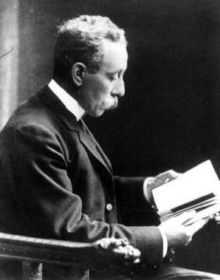Jacques-Louis Reverdin

Jacques-Louis Reverdin (August 28, 1842 - January 9, 1929) was a Swiss surgeon who was a native of Cologny.[1]
He studied at the University of Paris, becoming an interne of hospitals in 1865. In 1869 he became an assistant to Jean Casimir Félix Guyon (1831-1920) in the surgical department at the Hôpital Necker in Paris. Afterwards he moved to Geneva, where he eventually became chief surgeon at the Hôpital Cantonal de Geneve, and a professor at the University of Geneva.
In 1869, Reverdin performed the first "fresh skin" allograft.[2] The eponymous "Reverdin graft", also known as a "pinch graft", is a procedure for removing tiny pieces of skin from a healthy area of the body and seeding them in a location that needs to be covered.[3] His name is also associated with a specialized surgical instrument known as a "Reverdin suture needle".
In 1882, with his cousin[4] and assistant Auguste Reverdin (1848-1908), he observed that myxedema occurred as a delayed complication when the thyroid gland is surgically removed. He documented his findings in an article titled Note sur vingt-deux opérations de goitre. On September 13, 1882 he presented his observations to the Medical Society of Geneva.
He died in Pregny on January 9, 1929.
References
- Art and Medicine.com about "Note sur vingt-deux opérations de goitre"
- History of Organ and Tissue Transplantation
- Parts of this article are based on a translation of an equivalent article at the French Wikipedia.
- Reverdin, Jaques Louis in German, French and Italian in the online Historical Dictionary of Switzerland.
- ↑ Reverdin, Jaques Louis in German, French and Italian in the online Historical Dictionary of Switzerland.
- ↑ Organ transplantation by David Petechuk
- ↑ Mondofacto Dictionary definition of eponym
- ↑ Reverdin, Jaques Louis in German, French and Italian in the online Historical Dictionary of Switzerland.
|